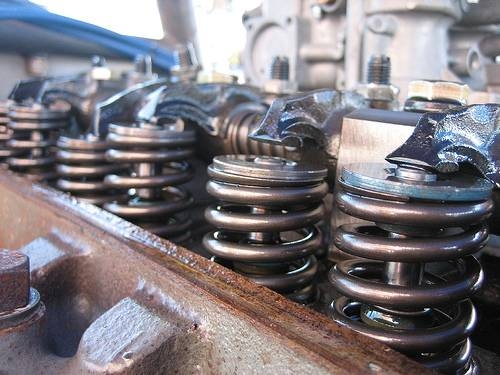
Inspecting the valve springs on your car is necessary for a complete cylinder head overhaul. Bad or worn out springs will wear valve stems and guides rapidly. If the springs have compressed after years of use, they may cause the valves to clatter, limit your engine rpm's, and even lead to valve-train damage. These simple tests will help you determine whether new spring valves are necessary before you finish your cylinder head overhaul.
Check the valve spring for squareness. This will let you know if the spring can load the retainers evenly: An uneven load will wear the valve stem and guide. Set the spring on a perfectly flat surface. Place a combination square against the spring and rotate the spring as you check for any gaps around it. Measure any gap with a feeler gauge. If any gap is above 1/16 inch, replace the spring. Check the rest of the valve springs.
Inspect the valve spring's free height. This inspection lets you know whether any of the springs has become too tired or has been affected by engine high temperatures, increasing its normal free height. Line up the springs next to each other in a perfectly flat surface. Place the edge of a straightedge on top of the springs. Measure any gaps between the straightedge and the top of the spring with a feeler gauge. If any of the springs' height varies by more than 0.0625 inches in relation to the rest, replace the springs.
Measure the spring free height. This check should be used along with the inspection you made on step 2 to decide whether springs replacement is necessary. Using a vernier caliper, measure the spring free height and compare your number with the specifications provided in your vehicle service manual. A variation of 1/16 inch may be within a reasonable limit unless you are going to use your vehicle mainly on heavy traffic, in mountainous terrain or to pull a trailer. Measure the rest of the springs.
Check the springs' load-producing capacity. When compressed to a certain height, a valve spring should have the strength to carry a proportional load. This characteristic is measured by compressing the spring against a valve-spring load tester in a vise. Compress the spring to the installed height specified in your vehicle service manual while reading the load tester. You should get a load capacity between 76 and 84 pounds or close to it. Replace the springs if necessary.